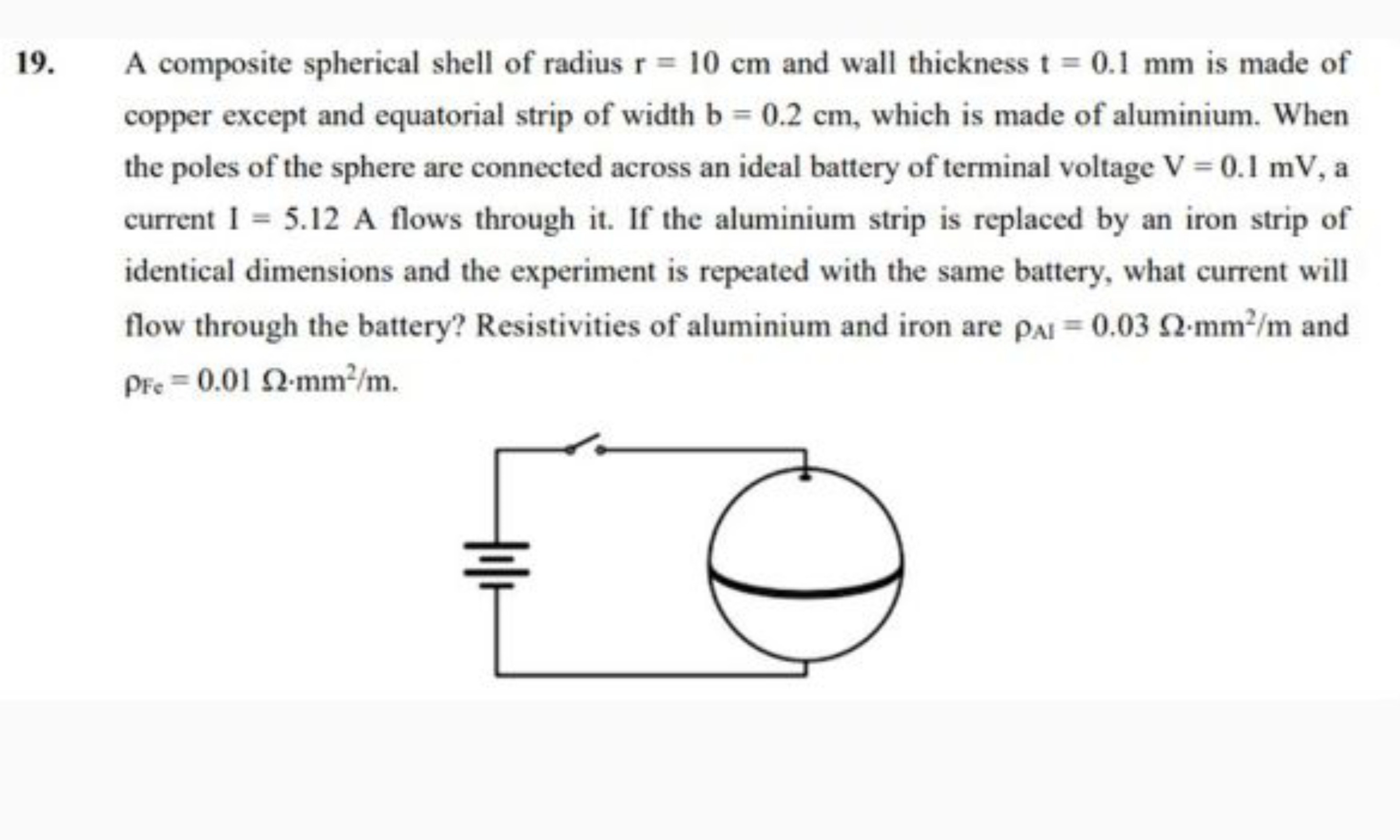Question
Question: A composite spherical shell of radius r = 10 cm and wall thickness t = 0.1 mm is made of copper exce...
A composite spherical shell of radius r = 10 cm and wall thickness t = 0.1 mm is made of copper except and equatorial strip of width b = 0.2 cm, which is made of aluminium. When the poles of the sphere are connected across an ideal battery of terminal voltage V = 0.1 mV, a current I = 5.12 A flows through it. If the aluminium strip is replaced by an iron strip of identical dimensions and the experiment is repeated with the same battery, what current will flow through the battery? Resistivities of aluminium and iron are ρAl = 0.03 Ω-mm²/m and ρFe = 0.01 Ω-mm²/m.

5.29 A
Solution
The problem describes a composite spherical shell made of copper with an equatorial strip of aluminium. Current flows from pole to pole when connected to a battery. This implies that the copper parts (two spherical caps) and the equatorial strip are connected in series along any meridional path. Since the current distributes itself over the entire surface, the effective resistance of the copper parts and the equatorial strip add up.
Let RC be the resistance of the copper part and Rstrip be the resistance of the equatorial strip. The total resistance of the shell is Rtotal=RC+Rstrip.
The resistance of a conductor is given by R=ρAL, where ρ is the resistivity, L is the length, and A is the cross-sectional area.
For the equatorial strip, the current flows across its width b. So, the length Lstrip=b. The cross-sectional area for the current flow is the circumference of the sphere at the equator multiplied by the wall thickness t. Astrip=(2πr)×t.
Given values: Radius r=10 cm=0.1 m Wall thickness t=0.1 mm=0.1×10−3 m Strip width b=0.2 cm=0.2×10−2 m Terminal voltage V=0.1 mV=0.1×10−3 V=10−4 V Initial current I1=5.12 A Resistivity of aluminium ρAl=0.03Ω⋅mm2/m=0.03×(10−3 m)2/m=0.03×10−6Ω⋅m Resistivity of iron ρFe=0.01Ω⋅mm2/m=0.01×10−6Ω⋅m
Step 1: Calculate the cross-sectional area of the strip. Astrip=2πrt=2π(0.1 m)(0.1×10−3 m)=2π×10−5 m2.
Step 2: Calculate the resistance of the aluminium strip (RAl). RAl=ρAlAstripb RAl=(0.03×10−6Ω⋅m)2π×10−5 m20.2×10−2 m RAl=2π×10−50.03×0.2×10−8Ω=2π0.006×10−3Ω=π0.003×10−3Ω.
Step 3: Calculate the total initial resistance (Rtotal,1). Using Ohm's law, Rtotal,1=I1V. Rtotal,1=5.12 A10−4 V=512001Ω≈1.953125×10−5Ω.
Step 4: Calculate the resistance of the copper part (RC). Rtotal,1=RC+RAl RC=Rtotal,1−RAl RC=1.953125×10−5Ω−π0.003×10−3Ω RC=1.953125×10−5Ω−π3×10−6Ω RC≈1.953125×10−5Ω−0.95493×10−6Ω RC≈19.53125×10−6Ω−0.95493×10−6Ω RC≈18.57632×10−6Ω.
Step 5: Calculate the resistance of the iron strip (RFe). The iron strip has identical dimensions as the aluminium strip. RFe=ρFeAstripb RFe=(0.01×10−6Ω⋅m)2π×10−5 m20.2×10−2 m RFe=2π×10−50.01×0.2×10−8Ω=2π0.002×10−3Ω=π0.001×10−3Ω.
Step 6: Calculate the new total resistance (Rtotal,2). Rtotal,2=RC+RFe Rtotal,2=(1.953125×10−5−π3×10−6)Ω+π1×10−6Ω Rtotal,2=1.953125×10−5Ω−π2×10−6Ω Rtotal,2≈1.953125×10−5Ω−0.63662×10−6Ω Rtotal,2≈18.89463×10−6Ω.
Step 7: Calculate the new current (I2). I2=Rtotal,2V I2=1.889463×10−5Ω10−4 V I2=18.89463×10−6100×10−6 A=18.89463100 A I2≈5.2926 A.
Rounding to two decimal places, I2≈5.29 A.
Explanation of the solution: The composite spherical shell's resistance is modeled as the sum of the resistance of the copper parts and the resistance of the equatorial strip, connected in series. The resistance of the strip is calculated using R=ρL/A, where L is the strip width and A is its cross-sectional area (2πrt).
- Calculate the cross-sectional area of the equatorial strip.
- Calculate the resistance of the aluminium strip using its resistivity and dimensions.
- Determine the total initial resistance of the composite shell using Ohm's law (Rtotal,1=V/I1).
- Subtract the resistance of the aluminium strip from the total initial resistance to find the resistance of the copper part (RC=Rtotal,1−RAl).
- Calculate the resistance of the iron strip using its resistivity and the same dimensions.
- Add the resistance of the copper part and the iron strip to find the new total resistance (Rtotal,2=RC+RFe).
- Calculate the new current using Ohm's law (I2=V/Rtotal,2).
